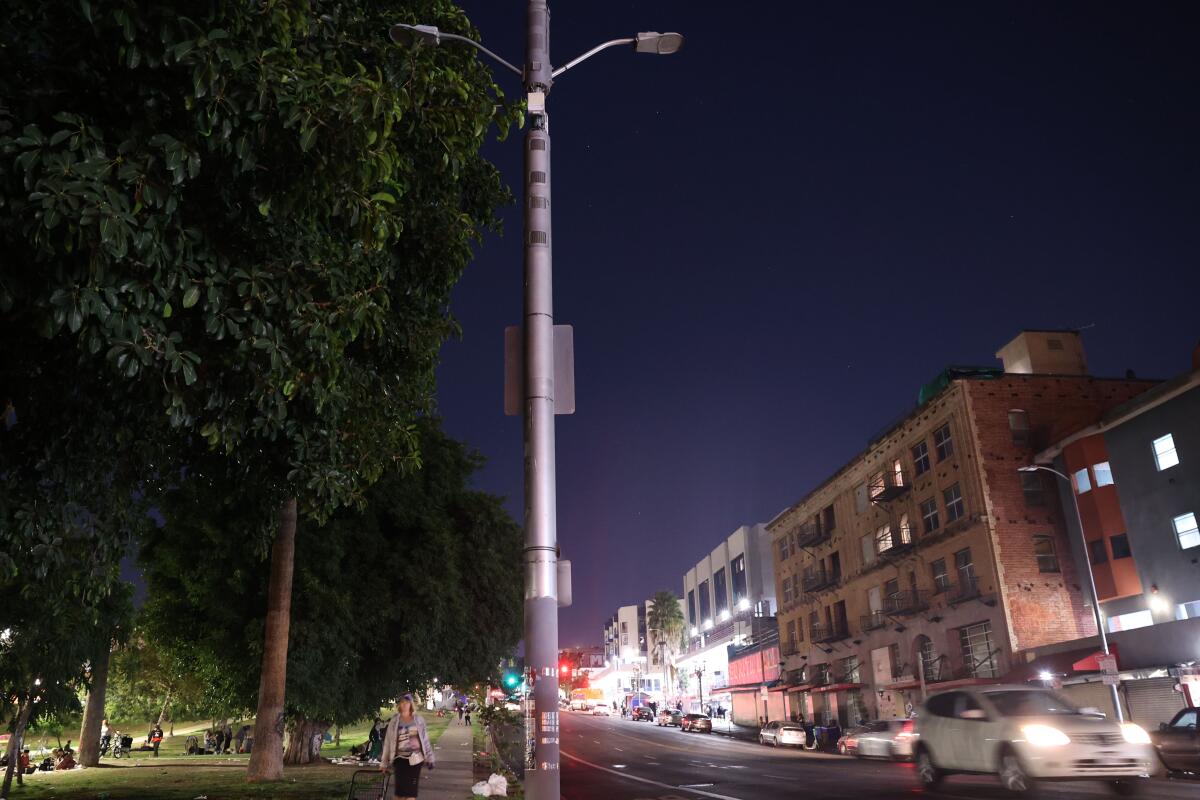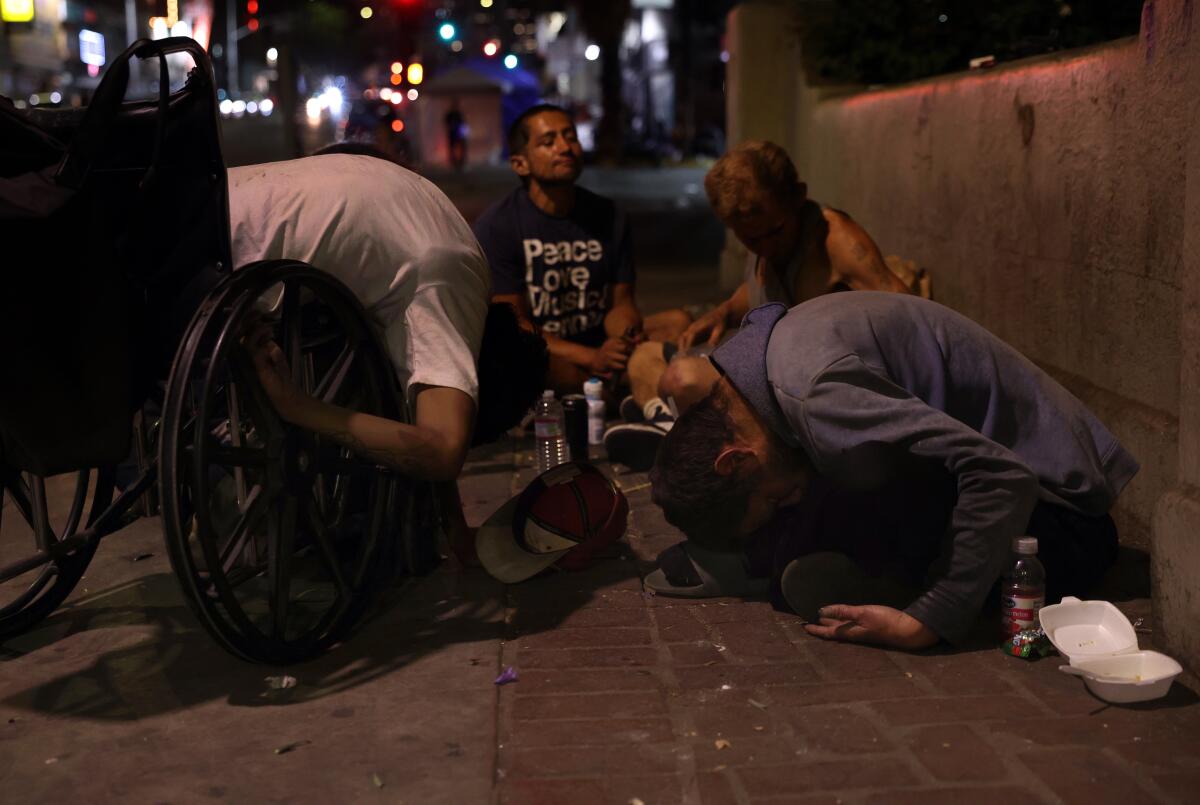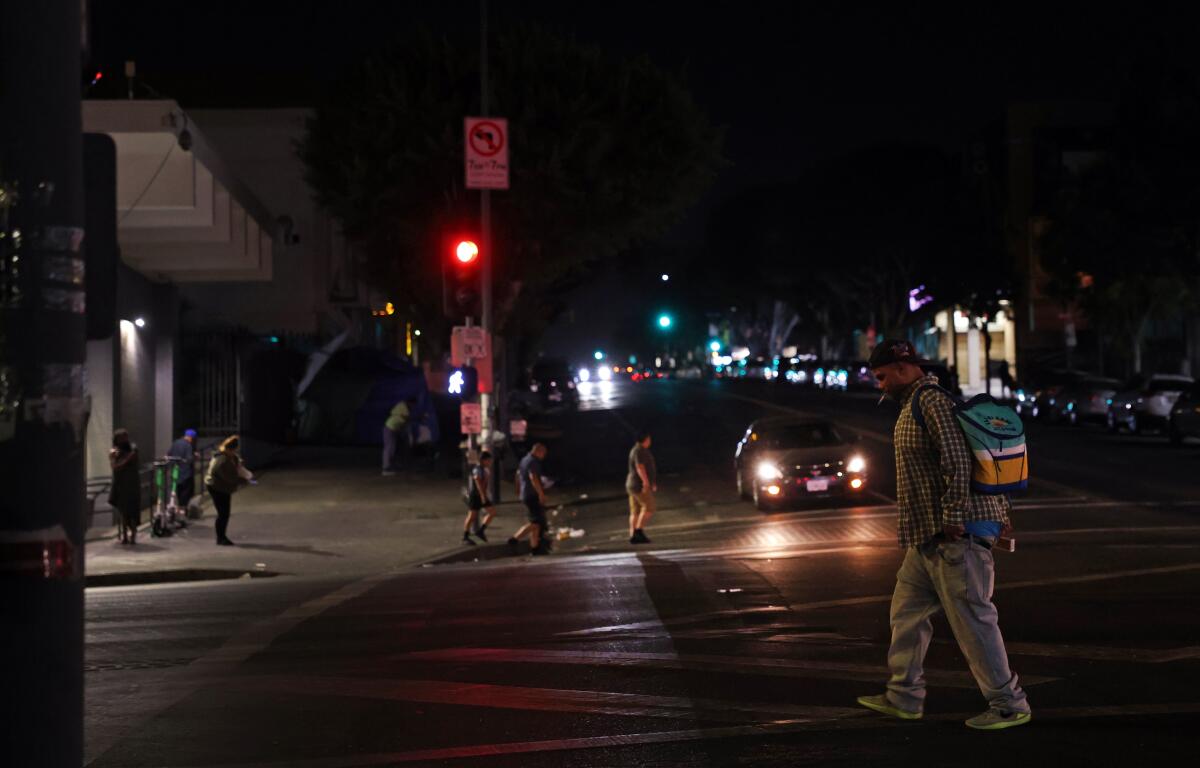Andrew Wolff stood in darkness, looking down Alvarado Street and conducting a visual inventory of broken streetlights on the eastern border of MacArthur Park.
“There are no lights all the way up to that corner,” Wolff said, pointing to Wilshire Boulevard and beyond. “Zero lights on both sides, down to Langer’s.”
That’s no small consideration, given the long history of criminal activity in the area and the number of drug-impaired people who wander in and out of the park, an epicenter of the raging fentanyl epidemic.
“I was driving yesterday and almost hit somebody. You can’t see, it’s so dark,” said Wolff, adding that the lights have been out for at least a year. “It’s been reported to everyone we know, and it’s not getting any responses.”
It’s been longer than that, said Eduardo Aguirre.
“It’s been maybe two to three years,” he told me. And unlike streetlights across the city that have been stripped of copper wiring and other materials by thieves, Aguirre said, these just needed basic maintenance, but nobody was expecting a fix anytime soon.
Wolff, Aguirre and Elaine Alaniz, all of whom serve on area Neighborhood Councils, were giving me a tour of their home turf, where lighting is just one of many issues. They said local merchants were reeling from thefts and gang threats, a new playground in the park had been damaged by fire, and the drug trade was brazenly visible day and night.
“I’ve worked with a lot of children, and I don’t think it’s OK for them to see this,” Alaniz said as we walked through a thicket of people who appeared to be either using drugs or recovering from the last hit.
We came upon a small group of people gathered on the edge of the park, and I pulled out my phone to show them a photo. It was a shot of a young woman whose mother and grandmother have been looking for her.

Many streetlights at or near MacArthur Park aren’t working. “It’s been reported to everyone we know, and it’s not getting any responses,” one local said.
(Michael Blackshire / Los Angeles Times)
“This is the place to look around, if she’s into drugs and stuff,” a middle-aged man said.
“I feel like I met her,” said his female companion, Serena Brown, who couldn’t quite remember where that might have been.
Brown, 46, said fentanyl is especially dangerous if you’ve been sober for a while, as she had been during a three-month stint in jail. Your tolerance level drops, and one strong hit can kill you.
“I’ve only OD’d one time, when I got out of jail,” Brown said. “Luckily I was around people who Narcanned me and saved my life.”
People will come running if someone has overdosed, she said, and not just to help. They figure that’s got to be potent stuff, Brown said, and they want to get their hands on some of it.
I asked if she’d turn things around, if she could get into a program. She said she was all but broke, looking for housing, and ready for a change.
“I would go to rehab if there was independent housing at the end of that, and I’m not saying I want it for free, either,” Brown said. “I would definitely go to rehab, 100 percent.”
But it’s hard to escape the urge to use, she said, especially with powerfully addictive fentanyl. And it’s taken court action to get local officials to add to the stock of beds for mental health and substance abuse treatment in the county.
“I think fentanyl is a horrible, evil drug,” Brown said.
Wolff and I asked if she’d lost any friends to overdoses.

People gather at the edge of MacArthur Park.
(Michael Blackshire /Los Angeles Times)
“Yeah,” Brown said. “I’ve lost 12 people.”
Eunisses Hernandez, the L.A. City Council rep for this area for almost two years, said she’d like to see city leaders move funding out of law enforcement and into community services, calling it a “care first” approach.
“This isn’t care,” Alaniz said as we took in the devastating toll of addiction and assorted untreated physical maladies. People were slumped over and hollowed out, like characters in a horror movie.
Aurora Corona, another neighborhood council member who lives near the park, told me she likes the notion of care first. But the situation is “out of control,” and that infuriates her because families who live in small apartments with no outdoor space have been frightened away from their park. Corona said she wants to see more law enforcement and a restoration of order along with the social services.
Hernandez told me she’s been frustrated, too, and at times “I feel like yelling about it at the top of my lungs.” Though she sees a role for police, she said, she thinks a greater percentage of the city’s money should be spent on lights, housing, sanitation and crime prevention.
Hernandez said she wants to expand her medical outreach team, which is run in conjunction with USC, and plans to start a mobile overdose prevention unit. She said she is strategizing with Mayor Karen Bass and using federal grants, philanthropic donations and other sources of funding for investments in the community, including an anticipated homeless service center and a redesign of the park.
Could those things make a difference? Sure, but in the working-class immigrant community of MacArthur Park, problems exist in large part because promises have not been kept.
When I wrote about Norm Langer saying he might retire and close his Westlake restaurant because of festering problems in the neighborhood, Bass went to hear him out over a pastrami sandwich. She later told me, “the bottom line is, we have to do whatever it’s going to take, and we have to respond urgently.”
When it takes a year or more to fix streetlights on major boulevards in the heart of the city, not far from City Hall, “urgency” is the last word that pops into your head, and cynicism comes naturally. The whole string of streetlights on both sides of Wilshire Boulevard, through the heart of the park, are out, although lights inside the park are working. Wolff has even produced a map of the outages.
Instead of working on redesigning the park, a $2.5-million undertaking, how about fixing the lights?
Hernandez knows the lights are out.

The whole string of streetlights on both sides of Wilshire Boulevard, through the heart of the park, are out, although lights inside the park are working.
(Michael Blackshire / Los Angeles Times)
Bass knows the lights are out.
Someone, anyone, needs to get the trucks and equipment moving to MacArthur Park.
Not in six months or a year or three.
Immediately.
Just fix the lights, for God’s sake.
Our last stop on the neighborhood tour was at the $1.3-million playground that opened earlier this year at the southwest corner of the park.
“This park is located right in the middle of one of the most densely populated neighborhoods in the entire city and county of Los Angeles,” Hernandez said at the opening ceremony in February. “The vast majority of our residents in this neighborhood live in apartments that don’t have access to green space in the form of a front yard or back yard.”
Wolff said the whole community was grateful. But he said he and his wife have made regular early morning visits to the playground to remove syringes before children arrive to play on the swings, slides and climbing structure.
And now there’s a much bigger problem to deal with. A fire, still under investigation, damaged part of the structure and melted a portion of the slide. The playground was fenced off, with yellow “Caution” tape wrapped around the perimeter.
Wolff looked on, disgusted. He wondered aloud why the park can’t be declared a drug-free, gang-free zone. He was wearing a “Free the MacArthur Park Neighborhood” T-shirt.
A young couple came by, pushing their 2-year-old son in a stroller.
“We brought him here almost every day,” the mom told me, saying she didn’t know where her son would play now.
Victor Williams, a neighborhood resident who was visiting the park with friends, said he can’t fathom all the destructive behavior, the trashing of the grounds and the wide-open drug activity. He referred to whoever was responsible for the fires as “savages.”
“Nobody speaks on it,” said Williams, disgusted by the silent acceptance of civic dysfunction.
But then he looked to the east, across a shimmering lake to the bejeweled downtown skyline.
“This park is so beautiful,” he said.
It has been, and could be. And for just a moment on a warm night in September, with its blemishes in shadows, it was.
steve.lopez@latimes.com
